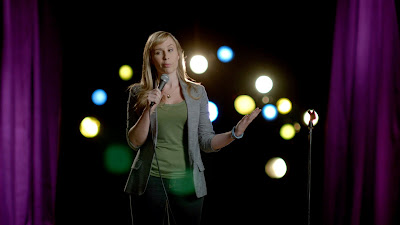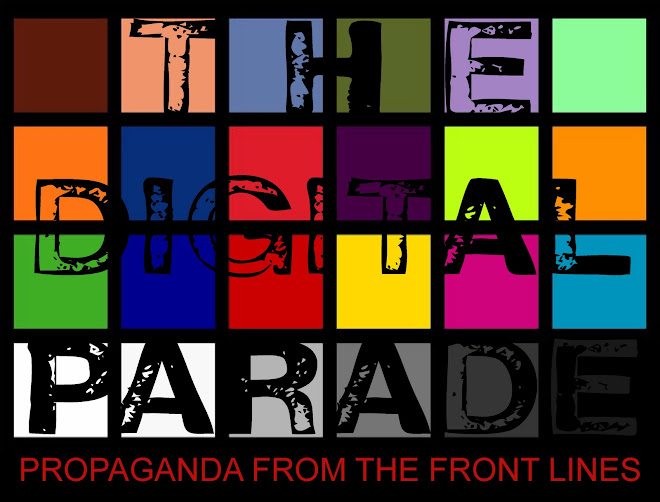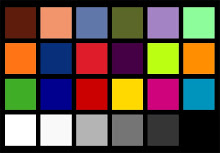I did make it to NAB this year and it was a lot of fun (and a lot of walking). I'll be posting about a few things that made an impression.
First up is a cool little camera made by Ikonoskop: the a-cam dII. Think of this thing as a Super 16mm Digital Cinema Camera. It sports a 2/3" CMOS sensor rated at 250 ISO. Whoa! Wait! Stop the whining! Yes, it's got a smaller sensor and yes it's a bit slow. But not every camera you shoot with needs to be rated from 800-36,000 ISO and include a VistaVision 17K chip. OK. So why do I dig this camera? Because it's got a feel and look all it's own. The camera is machined perfectly to sit in the palm of your hand and it is so well balanced with an appropriate lens (think Ultra 16mm Prime or DigiPrime NOT Master Prime) that it almost makes a hand held shoot comfortable. The a-cam shoots RAW CinemaDNG frames up to 30fps to internal SSD's for an HD or 2K finish. It's got a Global Shutter (a very good thing). And delivers a very specific, filmic image. The camera is not super clean like a RED or a Sony. It's got guts and texture. The images I demoed were very pleasing and film-like with nicely blown highlights.
The a-cam dII is shipping right now and will run you about $10,000 USD. With a bunch of SSD's and some interchangeable lens mounts (PL, B4, Canon, Nikon) expect to pay about 15K.
The last (but not least) super-awesome-cool thing about the a-cam is that there is a Black & White version. No. For real. You don't just take the saturation to zero in post. Ikonoskop actually built a camera without a Bayer filter and the results are way sweet. There's just a bit of test footage to look at (snowmobiles) but I can't wait to see more from the a-cam dII Panchromatic. By ditching the filter this camera gets better dynamic range and sensitivity (I think I was quoted 320 ISO).
More to come...
Sunday, April 22, 2012
Thursday, April 12, 2012
LUTs R US
One of my favorite aspects of the job is getting involved with "look creation". Working with the DP and Director, the D.I.T. (if equipped with the proper tools) has the ability to previsualize the final look of a project right from the set, in real-time. All one needs to accomplish this is the ability to build what I like to refer to as "creative LUTs". Again, a LUT (Look Up Table) is simply an image transform saved as a simple text file. And it looks just like this:

OK. So this might just look like a bunch of numbers on a page. Well, in fact, that's all it really is. A LUT simply changes a unique point of an image into something else. Like, for instance, a grey pixel with a value of 500 (say right in the middle of a 10-bit coded value scale of 1024 values) into a white pixel with a value of 900. A LUT will change luminance (gamma) and chroma (color). And from both of these we get the ability to apply color correction.
The trick here is not to just do simple shot-to-shot color correction (like slightly adjusting exposure and color to match between cuts) but to actually build the look of the scene through manipulating gamma and RGB levels. Sometimes this can be as simple as timing the picture a bit "cooler" or "warmer". Perhaps "crushing the blacks" and "pulling out the saturation" as well.
There are a number of software apps available on today's market that have the ability to generate interactive, real-time color correction with the added benefit of exporting a saved LUT file. Some of the most popular include Truelight, Link Color, 3CP, LightSpace CMS, LiveGrade, and my personal favorite SpeedGrade OnSet (though it has been left to die and just recently resurrected).
These days my preferred workflow is to build a LUT onset via SpeedGrade while monitoring a live feed from the camera. After the look is approved by my Director and DP I export the LUT (usually I build a LUT per each specific scene) into DaVinci Resolve and apply it to the camera original material. Once I've got the look into Resolve I can tweak it a bit further and then match it across different takes and shots to build a cohesive look for the project.
One of the more interesting projects I've worked on recently was a new campaign for feminine products from Kotex. (.......) The spots were constructed in such a way that each 30-second piece included numerous vignettes with their own individual creative look. These spots were directed by Jordan Vogt-Roberts and lensed by Jo Willems. We shot with an ALEXA and a variety of prime lenses including Zeiss Superspeeds, old Cooke Speed Panchros, and a set of Super Baltars. Each look was built from the ground up with a combination of set and costume design, lighting, lens choice, filters, and a creative LUT. Below are stills from the actual LUTs we built and employed on the set (and that were burnt into the dailies for editorial to cut with).
The first LUT we built was meant for a natural look of our comedians on stage. It is a basic Alexa Log C to rec709 transform with a bit of added contrast.

This cheerleader scene was augmented with multiple color grad filters in front of the lens (chocolate soft edge I think). Jo and I pushed the image toward a burnt yellow while simultaneously jacking up the saturation on just the green astro-turf of the field.

The 70's retro look was created with a combination of Super Baltar lens, diffusion filters, and a tweaked out LUT. We lifted the blacks of the image and added a ton of red to them. This has the effect of skewing the rest of the colors and gives the image a sense of old, decaying film stock.

More grad filters were employed for the yoga scene. I think we ended up stacking a chocolate, tobacco, and blue soft edge grad for this shot with an added white promist diffusion filter! Our LUT was fairly reserved as we had built the image up mostly in front of the lens instead of after the sensor.

This final sequence of the stuffy board meeting was tweaked to be a bit drab. Our LUT shifted the color balance towards a cool look while desaturating the image overall.

So after all of this work you've got to wonder if our "look" on the set made it to the "look" of the final aired spot. Go ahead and see for yourself:
So here's a link that will allow you to download some crazy "retro" LUTs (including the one I used for the doctor scene) for your own use (click "File" at the top left of the screen and scroll down to "Download"). Now please remember that these were custom built files that fit a very specific set of circumstances (Alexa, Super Baltars, Diffusion, etc) so these may or may not work for your other material. But once you've got them applied you should be able to tweak your gamma and saturation a bit to get them to look about right.
Have fun!

OK. So this might just look like a bunch of numbers on a page. Well, in fact, that's all it really is. A LUT simply changes a unique point of an image into something else. Like, for instance, a grey pixel with a value of 500 (say right in the middle of a 10-bit coded value scale of 1024 values) into a white pixel with a value of 900. A LUT will change luminance (gamma) and chroma (color). And from both of these we get the ability to apply color correction.
The trick here is not to just do simple shot-to-shot color correction (like slightly adjusting exposure and color to match between cuts) but to actually build the look of the scene through manipulating gamma and RGB levels. Sometimes this can be as simple as timing the picture a bit "cooler" or "warmer". Perhaps "crushing the blacks" and "pulling out the saturation" as well.
There are a number of software apps available on today's market that have the ability to generate interactive, real-time color correction with the added benefit of exporting a saved LUT file. Some of the most popular include Truelight, Link Color, 3CP, LightSpace CMS, LiveGrade, and my personal favorite SpeedGrade OnSet (though it has been left to die and just recently resurrected).
These days my preferred workflow is to build a LUT onset via SpeedGrade while monitoring a live feed from the camera. After the look is approved by my Director and DP I export the LUT (usually I build a LUT per each specific scene) into DaVinci Resolve and apply it to the camera original material. Once I've got the look into Resolve I can tweak it a bit further and then match it across different takes and shots to build a cohesive look for the project.
One of the more interesting projects I've worked on recently was a new campaign for feminine products from Kotex. (.......) The spots were constructed in such a way that each 30-second piece included numerous vignettes with their own individual creative look. These spots were directed by Jordan Vogt-Roberts and lensed by Jo Willems. We shot with an ALEXA and a variety of prime lenses including Zeiss Superspeeds, old Cooke Speed Panchros, and a set of Super Baltars. Each look was built from the ground up with a combination of set and costume design, lighting, lens choice, filters, and a creative LUT. Below are stills from the actual LUTs we built and employed on the set (and that were burnt into the dailies for editorial to cut with).
The first LUT we built was meant for a natural look of our comedians on stage. It is a basic Alexa Log C to rec709 transform with a bit of added contrast.

This cheerleader scene was augmented with multiple color grad filters in front of the lens (chocolate soft edge I think). Jo and I pushed the image toward a burnt yellow while simultaneously jacking up the saturation on just the green astro-turf of the field.

The 70's retro look was created with a combination of Super Baltar lens, diffusion filters, and a tweaked out LUT. We lifted the blacks of the image and added a ton of red to them. This has the effect of skewing the rest of the colors and gives the image a sense of old, decaying film stock.

More grad filters were employed for the yoga scene. I think we ended up stacking a chocolate, tobacco, and blue soft edge grad for this shot with an added white promist diffusion filter! Our LUT was fairly reserved as we had built the image up mostly in front of the lens instead of after the sensor.

This final sequence of the stuffy board meeting was tweaked to be a bit drab. Our LUT shifted the color balance towards a cool look while desaturating the image overall.

So after all of this work you've got to wonder if our "look" on the set made it to the "look" of the final aired spot. Go ahead and see for yourself:
So here's a link that will allow you to download some crazy "retro" LUTs (including the one I used for the doctor scene) for your own use (click "File" at the top left of the screen and scroll down to "Download"). Now please remember that these were custom built files that fit a very specific set of circumstances (Alexa, Super Baltars, Diffusion, etc) so these may or may not work for your other material. But once you've got them applied you should be able to tweak your gamma and saturation a bit to get them to look about right.
Have fun!
It's Alive!

I am currently beta-testing Convergent Design's new ARRIRAW capable Gemini 4:4:4 recorder. And... the results are flawless. This is definitely the way to go for a world of reasons. The Gemini is less expensive, smaller, easier to use, and simply more powerful than other existing ARRIRAW-capable recorders.
I have used the Gemini numerous times recording uncompressed 4:4:4 DPX frames from an ALEXA but the option to record true ARRIRAW just can't be beat. The .ari files are recorded as unprocessed raw sensor data frames. They are strung together by a metadata header when accessed by software capable of reading ARRIRAW clips.

The free ARC (Arri Raw Converter) is an easy way to view ARRIRAW clips but playback can be a pain. Other popular color-grading software like Scratch or DaVinci Resolve will give you access to the files as well. For the past few days I have been recording ARRIRAW material with the Gemini 4:4:4 and color grading the material with DaVinci Resolve. The results are excellent. Uncompressed is the way to go and recording RAW is even better.
Wednesday, April 11, 2012
4K RAW

Here's a quick Pre-NAB news flash: get ready for more from the boys and girls at Convergent Design.
CD has just announced a new product: The Gemini RAW. This is a super high end 4K/2K/HD recorder capable of 4096x2160 recordings up to 60fps, 2048x1080 up to 120fps, and simultaneous 4K RAW / DNxHD 36 dual recording for your master and dailies. AS they say, it just keeps getting better...
Here's the full press release:
Convergent Design Unveils New Innovative 4K RAW Recorder
Convergent Design announced the newest member of their recorder series: Gemini RAW. This fifth generation design supports 4K RAW recording with live-preview and playback to a 4K monitor. Gemini RAW includes many industry leading, one-of-a-kind features, such as four camera recording / quad-split playback (in HD), AVID DNxHD™ CODEC (RGB and YCC), uncompressed RGB 444, stereo 3D, simultaneous recording of RAW/Dailies, and 120fps support (in 2K/HD).
Gemini RAW is a solutions-based recorder for digital cinema and multi-camera productions. It offers all the features of its’ award-winning 4:4:4 counterpart, with significantly greater processing power, while retaining the same size, power, and weight. A key feature of Gemini RAW is the six programmable 3G-SDI ports which can be configured as 4-In/2-Out or 2-In/4-Out. This innovative capability enables many unique configurations such as quad-input record /quad-split display or single-stream 4K RAW recording /4K monitoring. Furthermore, multiple stereo 3D output options include luma differencing, side-by-side, and anaglyph, among others.
Gemini RAW offers a future-proof solution that allows recording in high-quality HD (in DNxHD-220) and simultaneously in RAW / uncompressed. You can use the DNxHD footage for fast turnaround projects while archiving the RAW for future, higher-resolution / higher-quality productions. Alternatively, if your project requires RAW today, simply record RAW and DNxHD-36 proxy (for your dailies/offline work). Either workflow simplifies post-production while protecting your digital assets for future revenue streams.
Unlike most competitive products, Gemini RAW includes a built-in 5.0” 800x480 LCD touch-screen for live-preview and playback. Gemini RAW uniquely employs dual 1.8” SSD drives, greatly reducing size, weight and cost. Currently these drives support quad-stream recording up to 1080p30/2K RAW, single stream 4K RAW up to 30p, single stream 1080p/2K RAW up to 120fps (over dual 3G-SDI) or in some formats, the creation of two identical masters (auto backup). The Gemini RAW production kit includes (at no extra cost) a simple SSD transfer station compatible with widely available, low-cost USB 3.0, FW-800, and Thunderbolt adapters. In particular, the Thunderbolt adapter supports data-transfer rates in excess of 375Mbytes/sec from the Gemini SSDs to a fast RAID hard-drive.
Pending certification by ARRI®, Gemini RAW will support both ARRIRAW 16:9 (Alexa) up to 60fps and ARRIRAW 4:3 (Alexa Studio) up to 48fps. Full support for Weisscam/P+S Technik HD/2K RAW is also planned; including cameras from IO Industries, Lux Media Plan, and Indiecam. Our leading-edge design anticipates future support for yet to be announced 2K and 4K RAW cameras as well as even higher frame rates.
Gemini RAW is expected to begin shipping in late Fall 2012. Price is yet to be determined.
See the entire Convergent Design family of recorders in action on today’s leading cinema production cameras at NAB booth C9918. You can also visit our website: www.convergent-design.com or call: ++720-221-3861.
Editorial Contacts:
Dan Keaton: dan@convergent-design.com (++719-930-1376),
Amber Cowles: amber@convergent-design.com (++719-337-2776)
Do you think the Gemini RAW is capable of recording the new Sony F65's RAW output? Hmm. Only time will tell...
Monday, April 9, 2012
TV is Awesome ?
I got some sweet ARRIRAW news on the horizon but for now here's a couple of quick links to some Toyota spots that I worked on recently. These were shot by Jo Willems on an ALEXA with Master Primes. 90% was recorded to uncompresssed DPX frames via the new Gemini 4:4:4 recorder with a few shots getting the full ARRIRAW treatment via a Codex On-Board recorder.
Subscribe to:
Posts (Atom)

